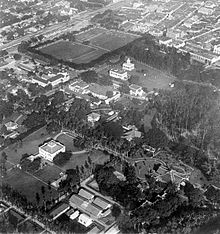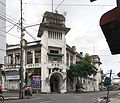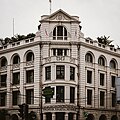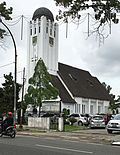List of colonial buildings in Medan: Difference between revisions
Rochelimit (talk | contribs) →Modernism (1920s-1940s): addde building |
Rochelimit (talk | contribs) added |
||
| Line 32: | Line 32: | ||
|[[File:COLLECTIE TROPENMUSEUM Bevolking voor het gouverneurshuis te Medan met spuitende fonteinen in de tuin ter gelegenheid van het huwelijk van Prinses Juliana met Prins Bernhard TMnr 60042405.jpg|center|120px]] |
|[[File:COLLECTIE TROPENMUSEUM Bevolking voor het gouverneurshuis te Medan met spuitende fonteinen in de tuin ter gelegenheid van het huwelijk van Prinses Juliana met Prins Bernhard TMnr 60042405.jpg|center|120px]] |
||
|[[File:Medan Wohnhaus des Praesidenten OKv Sumatra.jpg|120px|center]] |
|[[File:Medan Wohnhaus des Praesidenten OKv Sumatra.jpg|120px|center]] |
||
|- |
|||
|Agentschap van de [[Netherlands Trading Society|NHM]] (demolished in 1930, now Bank Mandiri) |
|||
|Agentschap van de [[Netherlands Trading Society|NHM]] |
|||
|1888{{sfn|Loderichs|1997|p=109}} |
|||
|anonymous |
|||
|{{coord|3.588925|98.677956|format=dms}} |
|||
| |
|||
| |
|||
|- |
|- |
||
|Dharma Deli Hotel |
|Dharma Deli Hotel |
||
| Line 164: | Line 172: | ||
|- |
|- |
||
|[[Medan City Hall|Gedung Balai Kota Lama]] |
|[[Medan City Hall|Gedung Balai Kota Lama]] |
||
|Raadhuis{{sfn|Loderichs|1997|p=16}} |
|Raadhuis, Gemeentehuis Medan{{sfn|Loderichs|1997|p=16}} |
||
|1908-1909{{sfn|Loderichs|1997|p=16}} |
|1908-1909{{sfn|Loderichs|1997|p=16}} |
||
|Ch. M. Boon{{sfn|Loderichs|1997|p=16}}<ref>http://colonialarchitecture.eu/obj?sq=id%3Apo%3A125 Boon, Ch. M.</ref> |
|||
|[[Hulswit & Fermont]], [[Eduard Cuypers]] |
|||
|{{coord|3.590380|98.677188|format=dms}} |
|{{coord|3.590380|98.677188|format=dms}} |
||
|[[File:Medan old city hall.jpg|120px|center]] |
|[[File:Medan old city hall.jpg|120px|center]] |
||
Revision as of 15:56, 6 March 2016

Colonial buildings in Medan include those that were constructed in Medan during the Dutch colonial period of Indonesia. Dutch colonial buildings were start to be build in Medan (at that time Deli) following the establishment of the Deli Company in 1869, whose establishment set Medan from a small kampong of few hundred people in 1869 into the largest city in Sumatra and the capital of North Sumatra in 1891 when the Sultan of Deli moved his residence here.[1] The rapid development ushered the growth of western-centric development in Medan, and hence a number of western-style architecture appears in Medan.[2][3] Despite its relatively late modernization in the late 19th-century compared to older established cities like Jakarta and Makassar, Medan contains an abundant colonial architecture heritages. 42 buildings has been declared of significant historical value.[4]
Colonial architecture in Medan is dominated with Rationalist architectural style, apparent in buildings such as houses, churches, civic buildings, commercial buildings and offices. European city planning based on garden city concept were also implemented in Medan, similar to Jakarta's Menteng and the mountain city of Bandung.
Despite the abundance of Dutch colonial architecture heritage in Medan, colonial buildings are being demolished at an alarming speed. Non-governmental organizations claimed that almost 90 percent of the 42 protected buildings had either been demolished or modified, despite the provincial ruling No. 6/1988 which bans the modification of these buildings. 73 buildings had not yet been protected, one example is the Mega Eltra buildings, constructed in 1912 but has since been demolished.[4] Other heritage buildings that have been demolished are the Kerapatan building on Jl. Brig. Jen. Katamso, a bank building on Jl. Pemuda and the Public Works office on Jl. Listrik.[4]
List of buildings
Below is a list of colonial buildings found in Medan. The list is divided into the colonial architectural styles: Eclecticism (before 20th century), Dutch Rationalism and Traditionalism (1900s-1920s), and Modernism (1920s-1930s). The list is sorted alphabetically according to its official (local) name. The list can also be sorted to each category.
Buildings which undertook complete renovation which resulted in different form are listed separately to distinguish the different architectural form.
Eclecticism (before 20th century)
Some of the first colonial buildings of Medan were concentrated around the Esplanade (now Lapangan Merdeka), the city square of Medan. Many of the first buildings were of simple wooden structure, such as the hoofdkantoor van de Deli Maatschappij te Medan which during the time of its opening in 1870 was also used for church, administration building, hospital and a feast hall.[5] Popular style at the time were the neoclassicism and eclectic Romanticism.[6] Buildings from the period were low in its architectural level due to the lack of skilled architectural practice. Structural engineers are provided easily by the builder, not by the government or by a private sector.[6]
| Last official name | Former names | Year | Architect | Location | Latest image | Oldest image |
|---|---|---|---|---|---|---|
| House of the President of OKv Sumatra, Gouverneurshuis te Medan |  |
 | ||||
| Agentschap van de NHM (demolished in 1930, now Bank Mandiri) | Agentschap van de NHM | 1888[7] | anonymous | 3°35′20″N 98°40′41″E / 3.588925°N 98.677956°E | ||
| Dharma Deli Hotel | Hotel De Boer[8] | 1898 (opened)[8] | 3°35′30″N 98°40′37″E / 3.591598°N 98.676851°E |  |
 | |
| Grand Hotel Medan (demolished, now Bank Negara Indonesia - KCP Medan Pulau Pinang)[9] | Hotel de Vink[9] | 1884[9] | 3°35′22″N 98°40′47″E / 3.589329°N 98.679815°E | |||
| Masjid Raya Al-Osmani | 1872 | 3°43′56″N 98°40′34″E / 3.732337°N 98.676074°E |  | |||
| Masjid Raya Medan | Grote Moskee | 1909 | Van Erp, JA Tingdeman | 3°34′30″N 98°41′14″E / 3.575111°N 98.687321°E |  |
 |
| Paleis van de Tengku Besar van Deli | Paleis van de Tengku Besar van Deli |  | ||||
| Sociëteit De Witte (first form, demolished)[9] | Sociëteit De Witte (first form) | 1882[9] | ||||
| Rumah Tjong A Fie 張阿輝 故居 | Tjong A Fie Mansion | 1900 |  |
 |
Rationalism and Traditionalism (1900s – 1920s)
New technological possibilities gradually transformed the architectural style into a modern form. Two architectural movements appeared in the Netherlands and the Netherlands East Indies: the Dutch Rationalism and Traditionalism.[10]
Dutch Rationalism was mainly inspired by the works of Berlage; the subsequent style in the tropical climate of Indonesia is known as New Indies Style.[11] The style is the result of the attempt to develop new solutions to integrate traditional precedents with new technological possibilities.
The Traditionalist movement appeared in the 1910s. It is basically the revival of the late 19th-century eclecticism, but was mainly inspired by classicism. Unlike the earlier low-quality architecture, the new traditionalist movement make use of modern materials e.g. reinforced concrete and steel frames. Facades are mostly of natural stone. The monumental character of this style is popular for offices, warehouses and garages.[10]
| Last official name | Former names | Year | Architect | Location | Latest image | Oldest image |
|---|---|---|---|---|---|---|
| Chinese lagere school |  | |||||
| Angkatan Muda Pembaharuan Indonesia (neglected, heavily deteriorates) | Medan's Warenhuis (1919), Kantor Departemen Tenaga Kerja Tk. I Sumut | 1919[12] | G. Bos[12] | 3°35′18″N 98°40′37″E / 3.588343°N 98.676836°E |  |
|
| Bank Indonesia | De Javasche Bank[5] | 1909[5] | E. Cuypers[5] | 3°35′27″N 98°40′37″E / 3.590752°N 98.676977°E |  |
 |
| BKS PPS (Badan Kerja-sama Perusahaan Perkebunan Sumatera), "Sumatra Planters Association" (1967) | AVROS (Algemeene Vereeniging van Rubberplanters ter Oostkust van Sumatera)[13] | 1918[12] | G.H. Mulder[12] | 3°35′04″N 98°40′50″E / 3.584420°N 98.680551°E |  |
 |
| Gereja Kristen Indonesia Sumatera Utara | Gereformeerde Kerk | 1918 | Tj. Kuipers | 3°35′02″N 98°40′18″E / 3.583877°N 98.671651°E |  | |
| Kantor Direksi PTP IX, Director's Office of PTP IX (abandoned) | Hoofdkantoor van Deli Maatschappij, head office of the Deli Company[5] | 1910[5] | D. Berendse[5] | 3°35′35″N 98°40′31″E / 3.592962°N 98.675214°E |  | |
| Kantor Pos Medan, "Medan Post Office" | Medan Post- en telegraafkantoor | 1911 | Snuyf (BOW) | 3°35′31″N 98°40′39″E / 3.591851°N 98.677404°E |  |
 |
| Gedung Balai Kota Lama | Raadhuis, Gemeentehuis Medan[5] | 1908-1909[5] | Ch. M. Boon[5][14] | 3°35′25″N 98°40′38″E / 3.590380°N 98.677188°E |  |
 |
| London Sumatera | 3°35′19″N 98°40′41″E / 3.588613°N 98.678080°E |  |
||||
| Katedral Medan, "Medan Cathedral" | 1905 |  | ||||
| Mega Eltra | Lindeteves-Stokvis (1912); BPM (1952) | 1912 |
Modernism (1920s-1940s)
The period saw the emergence of Modernism and its varieties, namely Art Deco, Nieuwe Bouwen, Amsterdam School and other variations. Art Deco evolved from earlier Dutch Rationalism. The form is symmetrical and exudes technological progress and glamour, with rich color and bold geometric shapes.
In the following period between late 1930s and 1940s, Art Deco evolved into a new style known as Nieuwe Bouwen (Dutch term for Modernism) or Functionalism. Instead of creating decorative style on the facade, the architect creates style in the clear arrangement of space. These Nieuwe Bouwen buildings were less symmetrical and more expressive in form, using simple universal form such as cylinder or tube, apparent in buildings such as the de Rex cinema building, now the Ria Restaurant (which was clumsily restored as Art Deco-style buildings).
| Last official name | Former names | Year | Architect | Location | Latest image | Oldest image |
|---|---|---|---|---|---|---|
| Asuransi Jiwasraya | NILLMIJ | 1919[12] | Thomas Karsten[12] | 3°35′03″N 98°40′48″E / 3.584277°N 98.680138°E |  |
|
| Bank Mandiri | NHM; Bank Bumi Daya[15] | 1930[12] | 3°35′20″N 98°40′41″E / 3.588925°N 98.677956°E | |||
| Bank Mandiri Medan, Lapangan Merdeka | de Factorij, NHM (1929); Bank Expor-Impor (1963)[15] | 1929[12][16] | Fermont en Ed Cuypers[12] | 3°35′22″N 98°40′40″E / 3.589581°N 98.677737°E | ||
| Gemeentelijke Vismarkt |  | |||||
| Nederlandsch Indische Gasmaatschappij (NIGM) |  | |||||
| Dinas Kebudayaan dan Pariwisata, "Department of Culture and Tourism" (deteriorating as of 2016) | Boekhandel en Drukkerij Varekamp & Co. (Bookstore and Printing Varekamp & Co.),[12] Drukkerij J. Hallermann[17] | 1926[12] | 3°35′06″N 98°40′50″E / 3.585084°N 98.680455°E |  |
||
| Gereja Huria Kristen Batak Protestan | 1912 | |||||
| GPIB Immanuel, "Immanuel's Protestant Church" | Nederlandse Hervormde Kerk | 1921 | 3°34′51″N 98°40′23″E / 3.580823°N 98.672941°E |  |
 | |
| PD Pasar | de Rotonde; Djawatan Penerangan Propinsi Sumatera Utara (1950s) | |||||
| Restoran Ria | de Rex | 1930s | ||||
| Rumah Sakit Santa Elisabeth (St. Elisabeth's Hospital) | Sint-Elisabeth ziekenhuis | 1929-1930[18] | J.M. Groenewegen[19] | 3°34′31″N 98°40′36″E / 3.575231°N 98.676731°E |  |
|
| Stasiun Kereta Api Medan, "Medan Railway Station" | Station, Medan Station | 1937 |
See also
References
- ^ Janssen 2015.
- ^ Dick 2002, pp. 95, 103.
- ^ "History". N.V. Deli Maatschappij. Retrieved 19 August 2015.
- ^ a b c The Jakarta Post, 2002.
- ^ a b c d e f g h i j Loderichs 1997, p. 16.
- ^ a b Gemeentemuseum Helmond, 1990, pp. 16–7.
- ^ Loderichs 1997, p. 109.
- ^ a b Loderichs 1997, pp. 16, 105.
- ^ a b c d e Loderichs 1997, p. 17.
- ^ a b Gemeentemuseum Helmond, 1990, pp. 20–1.
- ^ Gunawan Tjahjono 1998, p. 120.
- ^ a b c d e f g h i j k Loderichs 1997, p. 32.
- ^ Thamrin 2013.
- ^ http://colonialarchitecture.eu/obj?sq=id%3Apo%3A125 Boon, Ch. M.
- ^ a b Loderichs 1997, p. 89.
- ^ http://colonialarchitecture.eu/obj?sq=id%3Abt%3A373
- ^ http://kekunaan.blogspot.co.id/2014/04/gedung-dinas-kebudayaan-dan-pariwisata.html
- ^ "Cikal Bakal Rumah Sakit Santa Elisabeth Medan" [Origin of Medan's St. Elisabeth Hospital]. Rumah Sakit Elisabeth Medan (in Indonesian). Rumah Sakit Elisabeth Medan. 2015. Retrieved February 25, 2016.
- ^ "Ziekenhuis St. Elizabeth Medan" [Hospital St. Elizabeth, Medan]. Colonial architecture & town planning (in Dutch). TU Delft. 2016. Retrieved February 25, 2016.
Cited works
- "Medan loses its historical buildings". The Jakarta Post. Jakarta. June 5, 2002. Archived from the original on March 5, 2016. Retrieved March 5, 2016.
{{cite news}}: Cite has empty unknown parameter:|dead-url=(help) - Dick, Howard W. (2002). The Emergence of a National Economy: An Economic History of Indonesia, 1800-2000. Hawaii: University of Hawaii Press. ISBN 9780824825522. Retrieved March 2, 2016.
{{cite book}}: Invalid|ref=harv(help) - Gunawan Tjahjono, ed. (1998). Architecture. Indonesian Heritage. Vol. 6. Singapore: Archipelago Press. ISBN 981-3018-30-5.
{{cite book}}: Invalid|ref=harv(help) - Het Indische bouwen: architectuur en stedebouw in Indonesie : Dutch and Indisch architecture 1800-1950. Helmond: Gemeentemuseum Helmond. 1990. Retrieved March 30, 2015.
- Janssen, Peter (April 1, 2015). "Battle to preserve North Sumatra's smoking past". Nikkei Asian Review. Archived from the original on March 5, 2016. Retrieved March 5, 2016.
{{cite news}}: Cite has empty unknown parameter:|dead-url=(help); Invalid|ref=harv(help) - Loderichs, M.A. (November 1997). Medan - Beeld van een stad [Medan - Pictures of a city] (in Dutch). Purmerend: Asia Maior. ISBN 9074861105.
{{cite book}}: Invalid|ref=harv(help) - Thamrin, Mahandis Y. (August 19, 2013). "Kisah di Balik Kubah Megah AVROS Medan" [Story behind the majestic dome of AVROS, Medan]. National Geographic Indonesia (in Indonesian). Archived from the original on March 3, 2016. Retrieved March 3, 2016.
{{cite news}}: Cite has empty unknown parameter:|dead-url=(help); Invalid|ref=harv(help)
